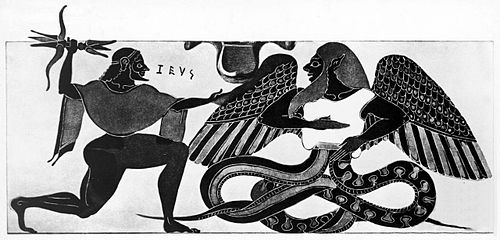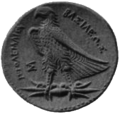Lightning bolt
In the fine arts, an attribute of ancient sky and weather gods that consists of stylized rays of lightning is referred to as a lightning bundle . Bundles of lightning were a symbol of the sky god, who ruled over gods and people as a thunderer and thunder. In heraldry , the lightning bolt is called a thunderbolt .
Old Orient
From the 3rd millennium BC, lightning bolts were used in the fine arts in the ancient Orient as an attribute of heaven and weather gods or as a stand-alone symbol. A lightning bundle consisted of 2 or 3 mostly zigzag or wave-shaped rays that were held together by a handle. Two lightning bundles opposite to one another could be combined to form a double lightning bundle, so that there was a handle in the middle. The images show the Mesopotamian god Adad on a bull with twin or double bundles of lightning.
- 1. God Adad with a bundle of lightning under the crescent moon and the sun on a bull, dating unknown.
- 2. God Adad with a bundle of lightning on a bull, around 2000–1600 BC.
- 3. God Adad with a double bundle of lightning on a bull, around 744–727 BC.
Ancient and modern times
Lightning bundles were also used in the fine arts of ancient Greece and Rome, and in modern times in the Renaissance, Baroque, and Historicism periods. They were used as an attribute of Zeus / Jupiter in sculptures, in reliefs and in painting or as individual symbols on coins.
In the orientalizing period (around 750–650) the ancient oriental iconography of the lightning bolt was transferred from the Greeks to their sky and weather god Zeus. The forms of the Orient were adopted, but transformed in the Greek spirit. The Greeks saw fire and light as flowers and, based on this view, represented the bundle of lightning as a lightning flower.
The Greeks used the common motifs of the lotus flower and the lotus bud to depict the lightning flower. The lightning bundle consisted of a single bud or flower or of an opposing composition of two buds, two flowers or one bud and one flower, so that a handle was created in the middle. The flowers could be composed of several calyxes. The buds could have helical grooves that resembled blazing flames. The outer sepals could be bent up and shaped into wings. In later times the lightning bolt developed into a pure ornament, the original meaning of which was no longer recognizable. Zeus / Jupiter is often shown accompanied by his holy eagle, the bundle of lightning in one hand and his scepter in the other. There are also depictions in which the eagle of Zeus clasps the bundle of lightning with its claws or its beak.
|
|
- 4. Zeus with a bundle of lightning and scepter, 2nd century AD.
- 5. Zeus throws a bundle of lightning at Typhon , around 540-530 BC.
- 6. Zeus eagle with a bundle of lightning in its claws, Greek coin, 336–280 BC.
- 7. Lightning bolt, Greek coin, around 432–421 BC.
- 8. Zeus with a bundle of lightning and scepter, red-figure amphora, around 500 BC.
- 9. Trophy with a winged bundle of lightning on a shield, a statue base in front of the New Palace in Stuttgart, 1823.
- 10. Eagle with lightning bolt, badge of a shako , 1860.
mythology
After Zeus had freed the Cyclops from captivity, they gave him lightning and thunder out of gratitude, with which he could defeat the gods of the titans . Since then, lightning and thunder have been the symbols of Zeus' divine power, with which he repeatedly intervenes in the lives of gods and people. So he ends the war between Greeks and Trojans with thunder and lightning, paralyzes the talkative Anchises at Aphrodite's request and kills Phaeton , the son of the sun god, who conjures up the fall of the earth with a wild ride in the sun chariot.
See also
literature
- Paul Jacobsthal: The lightning bolt in oriental and Greek art. Berlin: Weidmann, 1906, pdf, without panel I-II , panel I , panel II .
- Martin P. Nilsson: History of the Greek Religion. 1. The religion of Greece up to the Greek world domination. Munich: Beck, 1967.
- Percy Preston: Thunderbolt. In: Metzler lexicon of antique images. Stuttgart: Metzler, 1997, page 35.
- Adolf Rieth: The lightning bolt in the fine arts. Munich: Heimeran, 1953.
- Wolfgang Speyer: Thunderstorms. In: Georg Schöllgen (editor): Reallexikon für Antike und Christianentum: Non-fiction dictionary for dealing with Christianity with the ancient world. 10. Genesis - giant. Stuttgart: Hiersemann, 1978, column 1107-1172.
- Astrid Winter-Fritzsche: "Lifelike" lightning representations in Venetian painting of the 16th century with an introduction to the interpretation and representation of lightning. Frankfurt am Main: Lang, 1990, pages 26-35.
Web links
Footnotes
- ↑ #Jacobsthal 1906 , page 1-9.
- ↑ #Nilsson 1967 , page 362nd
- ↑ #Jacobsthal 1906 , page 10.
- ↑ #Jacobsthal 1906 , pages 12-13.
- ↑ # Jacobsthal 1906 , pages 10-49.
- ↑ #Preston 1997 .










